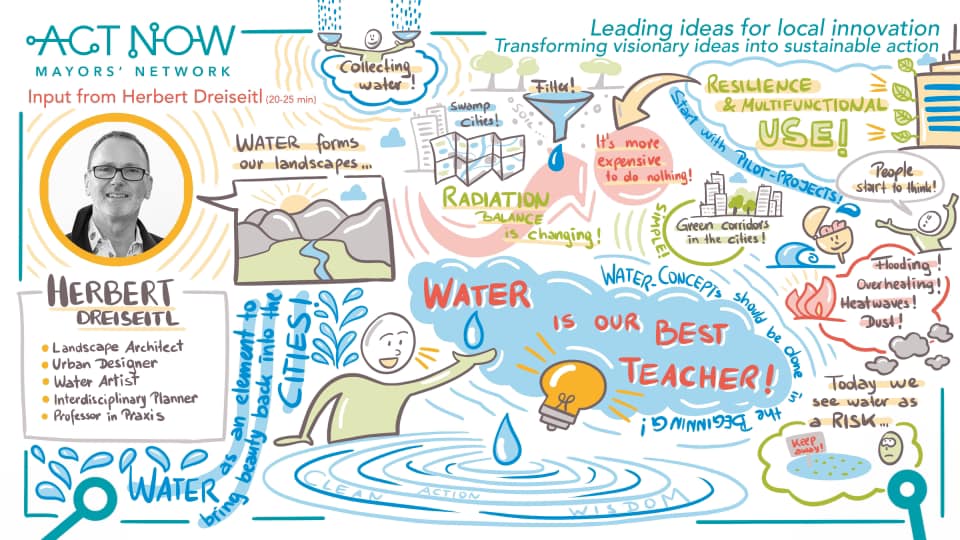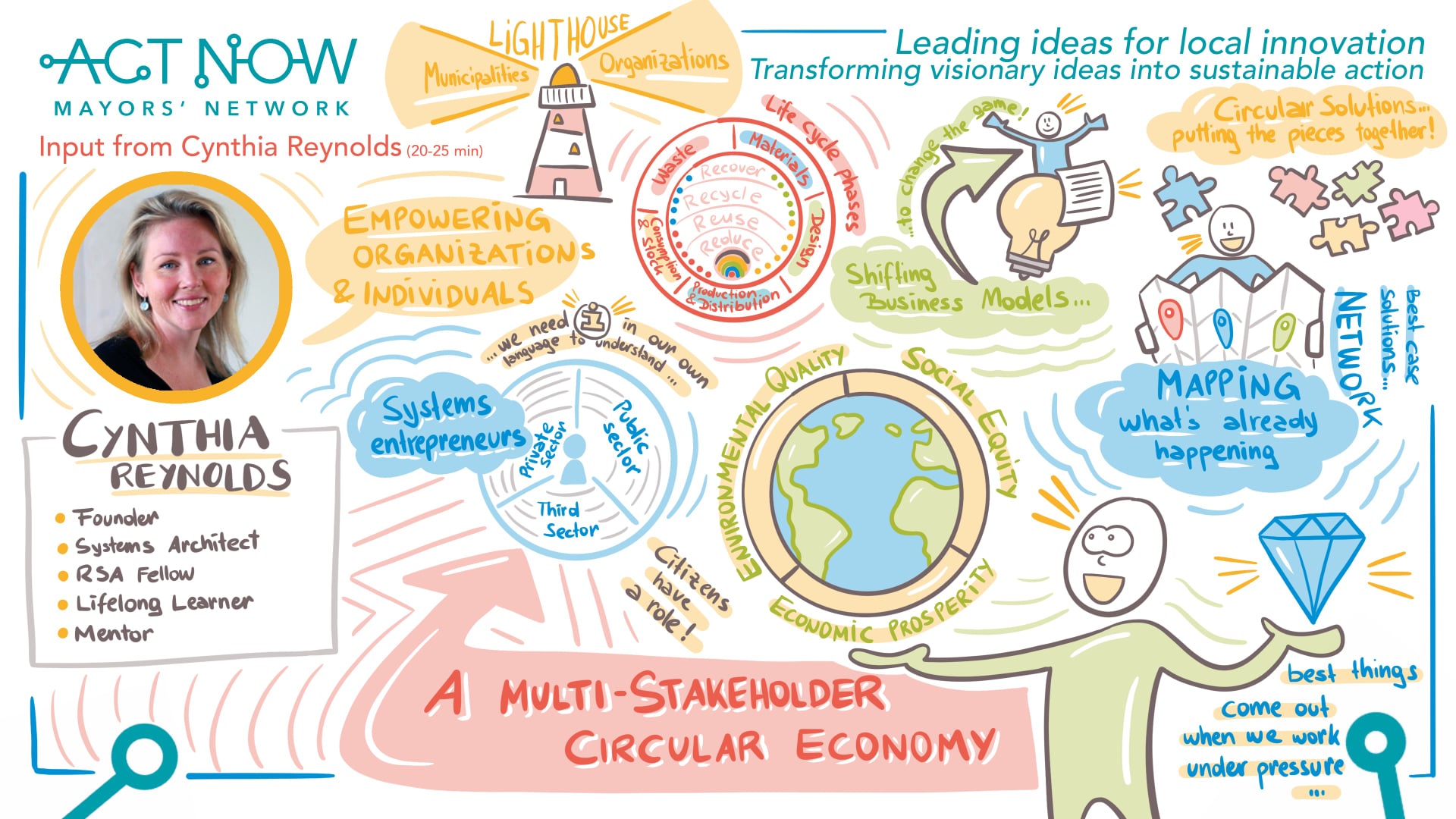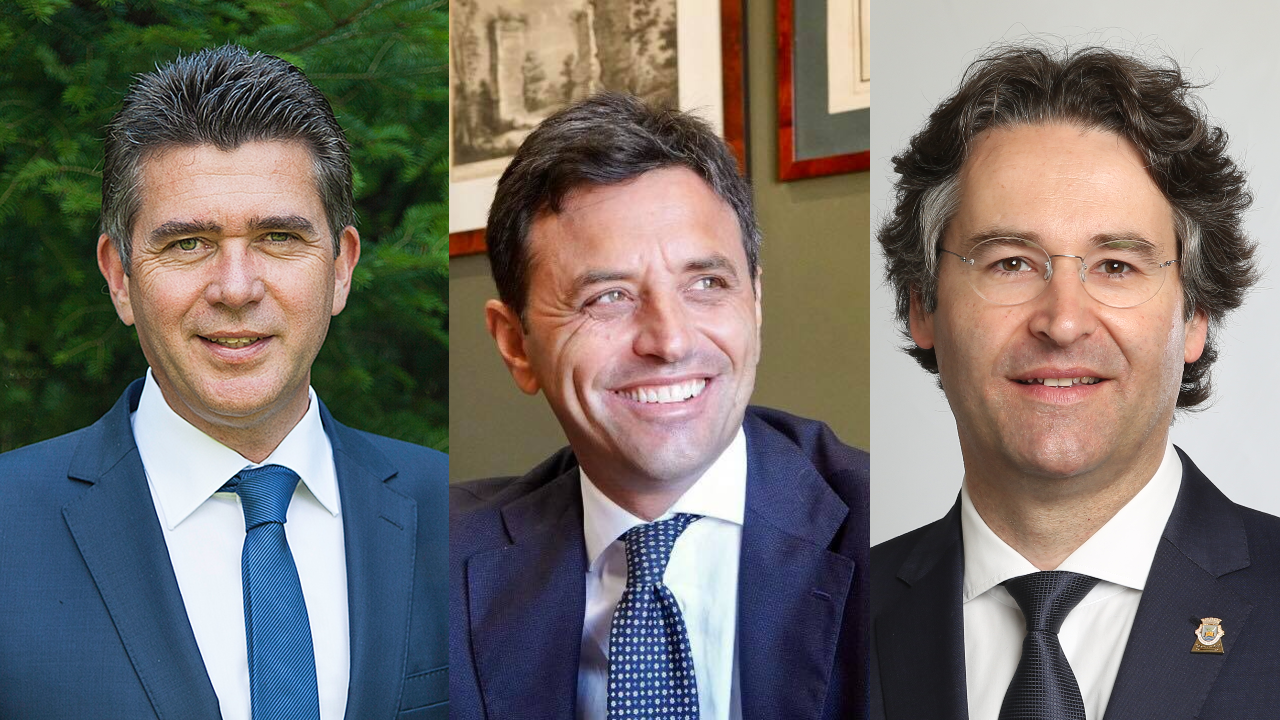In the built environment water is everywhere but not always visible and often not in our thoughts. We take water’s services for granted, making use of its enormous qualities and performance. In the short run, we might isolate the city from the environment, but to be truly sustainable for future generations, we need to be much more connected to the environment.
Fluid Thinking is an art that Herbert Dreiseitl developed throughout his career due to his deep dedication for water. Herbert Dreiseitl is a renowned landscape architect, urban designer, water artist, interdisciplinary planner, and a professor in praxis. He is an internationally highly respected expert in creating liveable cities with a special hallmark on the inspiring and innovative use of water to solve urban environmental challenges, connecting technology with aesthetics and encouraging people to take care of and establish a sense of ownership for places. He has realized ground-breaking contemporary projects around the world in the fields of climate resiliency, stormwater management, urban planning and landscape architecture like Potsdamer Platz (Berlin), Solar City (Linz), Offenbach Harbour, Tanner Springs Park (Oregon), or Bishan-Ang Mo Kio Park in Singapore. Herbert is working in his own company, DREISEITLconsulting GmbH based in Überlingen, Germany.
His work has a unique focus on water management. Dreiseitl grew fascinated with the dynamic and beauty of water ever since his childhood. He recalls several moments where he felt touched by the power but also the fragile side of this most important substance. “All people, whether they live in cities, villages or somewhere in the country are dependent on water as the source of all life”, he muses.
First, Dreiseitl was engaged in art. Working as an artist he conveyed an interest in people and their wellbeing. “I tried to help especially young people with drug problems and work with art and exercises on water structures to overcome fear and help to build trust in their abilities and confidence in the outside world. I also figured out an open and well-designed outdoor space is for their self confidence and trust in their neighborhood very important. Because the real connection of people, the real living room of a public society, is more outside in the public realm. Everything that people learn about democracy, about being really human, they learn in the open, outside, in contact with others”, he shares.
Over time, he discovered that he had to work with such public spaces and finally found that there was a profession called landscape architecture. Looking at his position today, he feels that he is working much beyond that specific profession. His work deals with parks and garden architecture, but also with art, social science, engineering and – very important – with urban planning. At the confluence of these fields, he has found that landscape architecture is too narrow in its traditional form. “Today in times of climate crisis and loss of nature we need to expand. We must reinvent landscape architecture and grasp it in a more modern inclusive way”, he prompts.
In this interview, we spoke with Dreiseitl about his experiences and works, which integrate regenerative processes, demonstrating a portfolio of site-responsive interventions of community-based urban planning, nature-based solutions, and environmentally sensitive engineering in cities of Europe, Asia, and worldwide.
What are a few urban projects that illustrate your approach to designing with water?
When I started with my first concepts and pilot projects in 1980, some people made jokes about my passion and topic. Within the recognition of extreme climate conditions and the growing awareness that urban regions and cities are affected most, the need to act is growing and in today’s discussion.
Many cities no longer waste time and develop proactive planning tools for water management and interconnection. I have been on the forefront of this development and will mention some cases:
Let’s start with Nordic cities like Oslo or Copenhagen. In both cities, I have introduced a new approach and concept to work more sustainable with the citywide water regime. Together with my team we worked on several projects that primarily aim to slow down the runoff, avoid flooding and increase health and biodiversity. These challenges are often the biggest problem we have in cities. We have covered too much ground surface with concrete or asphalt, and now we need to change it and incorporate water-friendly treatment and technologies in the urban space – infiltration belts, retention swales, and ponds and so on. The second thing we can do is to clean the water, we can have smaller cleaning units like cleansing and sedimentation in swales and biotopes integrated in the cityscape providing not only better water quality but also better air quality and buffering temperature extremes all over the city. Greenery can also act as a filter, improve not only water but also air-quality and buffer heatwaves. I have been giving keynotes and teaching at many conferences like in Ostrava (Urbanscapes 2019), Istanbul, Athens, Vienna, and many others, explaining the principles and presenting many great examples.
Cities such as Hamburg, Copenhagen, Oslo, Stuttgart, Munich, Vienna, all major cities move now in this direction. And of course, outside Europe, New York, Chicago. In Chicago I was working to create the greenroof on the townhall that lead to Chicagos general Green Roof Program, likewise in New York, with its BIG U (flood protection project) and filtration system. Furthermore, cities in Asia, China and last not least in Singapore with the ABC Waters Program. Cities around the world come up with strategic plans to proactively work with water, both at city level and street or property level. In cities it is necessary to work with both; with permanent water like ground- lake- and river water but also with temporary waters like rain. Like to retain rainwater, filter and soak it up into the soil or let it evaporate not only in parks but also in residential areas and streets is not only better for flood protection, to avoid dry dusty urban landscapes but also to be climate resilient and avoid heat-island effects. Water management needs to be decentralized and operated on the basis of a large number of different network-based treatments. This approach is important not only because of the presence of water itself, but also to improve the microclimate in the city. Water and the associated greenery have been shown to purify and cool the air, and these interrelated relationships make cities more resilient, more resistant to climatic change and finally more beautiful and livable.
What are some concrete examples of opportunities for green corridors in municipalities?
The green corridor at the Kallang River Valley in Singapore is a very special case but the topic is most relevant to many places. I created with my team and local engineers a green lung for water, greenery, bio habitat and people. This has been most successful. No more flooding further downstream, much more biodiversity, better livability and space for social and nature interaction.
And on top of that we collect rainwater for the freshwater supply of the city!
Many large cities around the world take water from their surrounding countryside and hinterland, sometimes from far away from a great distance. It can be lakes, rivers, including boreholes to get valuable groundwater. In short, it is brought to cities from somewhere, is used, polluted and released as dirty water back into the rivers and the environment. This is still happening in many places around the world. Singapore is an island and has no hinterland. With over 5,5 million inhabitants Singapore is literally dependent on every drop of water. Up to 2010 most rainwater was collected in monsoon drains and quickly brought into the sea. By the way in most cities, all rainwater flows into the sewer where it mixes with wastewater. In heavy rains, the sewage system is not big enough to accommodate the volumes of storm water rainfall and contaminated mixed water flows directly into streams and rivers. In Singapore every raindrop is collected and forced to transform this outdated disposal to a collection and recycle-system. With a growing demand for water, not only for drinking in households, but also for industry and argotech the old systems had to be transformed and I am proud to be involved in this transition. With the help of the ABC (Active, Beautiful, Clean Waters Program) guidelines, we are now trying to treat, retain and preserve rainwater in the city.
If there are so many opportunities, what are the obstacles hindering green-blue infrastructure to be implemented?
I think the biggest obstacle is not having a clear perspective and plan for the future. A city needs to develop a clear picture where it likes to be in 15 – 25 years from now. Therefore, clear leadership is needed but also engagement of all stakeholders.
Mayor and City bureaus offices, water agencies and their representatives but even more the normal population needs to be involved. If they do not accept the idea of blue-green infrastructure, it is nearly impossible to implement BGI in the urban landscape. Secure water supply and flood prevention are enormous priorities for a city. The risks of failing in either of those mandates can be a huge political, economic, and social disaster for a city. Therefore, water agencies are risk-averse and view new paradigms as suspect, apparently following the maxim “If it ain’t broke, don’t fix it.”
Very often old school engineering is holding nature-based solutions and new sustainable technology back, but education and positive good cases can open doors, build trust and turn obstacles into opportunities. For this reason, perhaps more than any other, engineers and water agencies are the most frequent institutional bottleneck. Even once water agencies could be convinced of the possibilities and advantages of BGI, I still have found it to be the most effective to give the final authority for BGI implementation to them but with a clear order to move forward on sustainable climate resilient solutions.
With clean water becoming a scarce resource in many countries, how can cities help create new policies in regards to water? How can designers and planners enable cost-effective ways to reduce water waste?
At present cities are too much dependent on water from surrounding landscapes and leaving drought and problems behind for their needs. I think in the future cities will have to recycle much more and use different qualities of water for different purposes. It will be more necessary to catch, store and reuse water. Many regions and cities could also move in this direction. Smart cities investing and working with water will always be an asset. Vienna is doing this already in certain areas and in Budapest we are currently planning for projects with similar efforts. The awareness is growing and Singapore is far ahead becoming from a third world economy country to a world leader in the development of technology and treatments, and as a visiting professor for landscaping and water management I am very proud to be a consultant to the city’s agencies.
It is not only the development of new technologies, but also the integration into the urban space and urban landscape that makes Blue-Green Infrastructure projects successful. Nature based solutions are stable and very cost efficient. To design a city with its water-system in a sustainable manner does not mean it has to be expensive. It is the opposite; a well-designed system that is also beautiful lasts much longer and is appreciated by the public.
And finally, it is about the involvement of the public. Cities cannot be changed without people and this is a very interesting challenge especially for our profession. To reduce maintenance and avoid vandalism, it is most relevant to engage the population to be part of the solution.
How can mayors use water as an element to bring beauty, health and sustainability into cities? In your opinion, how does a holistic approach factor into this kind of municipal decision-making?
For too long we’ve pushed water underground, out of sight – out of mind … and disregarded green. Though essential to our lives it lacked a strong advocate. But times change and suddenly we’ve become aware that Grey can’t cope with the challenges of climate change.
Changing the paradigm of urban water infrastructure towards Blue-Green Infrastructure thinking is a political-institutional and a cultural task. In general, the obstacle to shifting the paradigm is much less about the technical demands of implementing BGI within the urban space, and much more about organizing responsibility for different BGI responsibilities.
Most people are averse to change and to accepting new or different responsibilities. However, providing convincing arguments that demonstrate the many benefits of BGI can go a long way towards gaining support from experts. In turn, rallying experts is an important step in institutionalizing the BGI approach in a more general way within a city.
I have been working in many cases with mayors and cities and the starting point is always a strong advocacy, a personality that is standing behind and a clear vision that is strong enough to pull others to act and go in the right direction.
If you were mayor, which concrete measures would you implement in your city?
First, I would create a master plan concept with clear goals like Green Ratio Proportions and sustainable water-systems with targets like % on retention and recycling.
I would define first pilot-projects and push for its realization beyond too many restrictions and conservative outdated regulations.
But I would also involve early on good consultancy from outside with a fresh and professional perspective.
With all that in mind, marketing and public engagement would be my strategy for all projects so it will create a culture of common sense and hopefully soon become a main trend.


